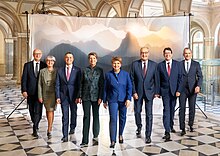
In Swiss politics, the magic formula (German: Zauberformel, French: formule magique, Italian: formula magica, Romansh: furmla magica) is an arithmetic formula for dividing the seven executive seats on the Federal Council among the four coalition parties. The formula was first applied in 1959. It gave the Free Democratic Party (now FDP.The Liberals), the Catholic Conservative Party (later Christian Democratic People's Party, now The Centre) and the Social Democratic Party two seats each, while the Party of Farmers, Traders and Independents (now the Swiss People's Party) received one seat.[1]
The formula is not a legal requirement but the result of an agreement among the four large coalition parties. After the 2003 general election, the formula was modified, giving two seats to the SVP/UDC at the expense of the Christian Democrats.[2] This was because the Swiss People's Party received 29% of the votes in the election, making it Switzerland's largest party by vote share.
- ^ "Formule magique" (in French). Dictionnaire historique de la Suisse. Archived from the original on 7 March 2012. Retrieved 8 May 2012.
- ^ "Federal councillors and their parties". Swiss Government. Archived from the original on 2 March 2022. Retrieved 9 March 2022.